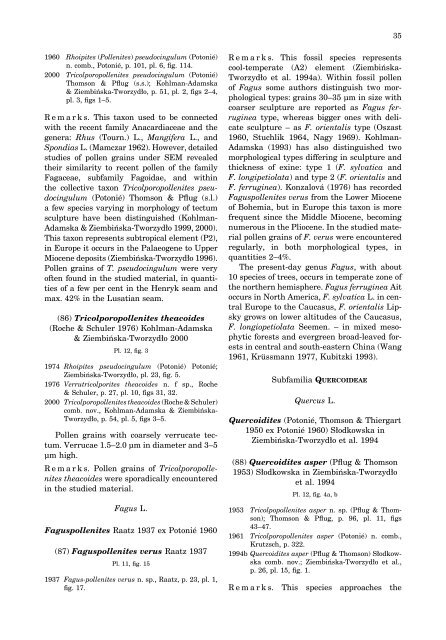Middle Miocene palynoflora of the Legnica lignite deposit complex ...
Middle Miocene palynoflora of the Legnica lignite deposit complex ...
Middle Miocene palynoflora of the Legnica lignite deposit complex ...
You also want an ePaper? Increase the reach of your titles
YUMPU automatically turns print PDFs into web optimized ePapers that Google loves.
1960 Rhoipites (Pollenites) pseudocingulum (Potonié)<br />
n. comb., Potonié, p. 101, pl. 6, fi g. 114.<br />
2000 Tricolporopollenites pseudocingulum (Potonié)<br />
Thomson & Pfl ug (s.s.); Kohlman-Adamska<br />
& Ziembińska-Tworzydło, p. 51, pl. 2, fi gs 2–4,<br />
pl. 3, fi gs 1–5.<br />
R e m a r k s. This taxon used to be connected<br />
with <strong>the</strong> recent family Anacardiaceae and <strong>the</strong><br />
genera: Rhus (Tourn.) L., Mangifera L., and<br />
Spondias L. (Mamczar 1962). However, detailed<br />
studies <strong>of</strong> pollen grains under SEM revealed<br />
<strong>the</strong>ir similarity to recent pollen <strong>of</strong> <strong>the</strong> family<br />
Fagaceae, subfamily Fagoidae, and within<br />
<strong>the</strong> collective taxon Tricolporopollenites pseudocingulum<br />
(Potonié) Thomson & Pfl ug (s.l.)<br />
a few species varying in morphology <strong>of</strong> tectum<br />
sculpture have been distinguished (Kohlman-<br />
Adamska & Ziembińska-Tworzydło 1999, 2000).<br />
This taxon represents subtropical element (P2),<br />
in Europe it occurs in <strong>the</strong> Palaeo gene to Upper<br />
<strong>Miocene</strong> <strong>deposit</strong>s (Ziembińska-Tworzydło 1996).<br />
Pollen grains <strong>of</strong> T. pseudocingulum were very<br />
<strong>of</strong>ten found in <strong>the</strong> studied material, in quantities<br />
<strong>of</strong> a few per cent in <strong>the</strong> Henryk seam and<br />
max. 42% in <strong>the</strong> Lusatian seam.<br />
(86) Tricolporopollenites <strong>the</strong>acoides<br />
(Roche & Schuler 1976) Kohlman-Adamska<br />
& Ziembińska-Tworzydło 2000<br />
Pl. 12, fi g. 3<br />
1974 Rhoipites pseudocingulum (Potonié) Potonié;<br />
Ziembińska-Tworzydło, pl. 23, fi g. 5.<br />
1976 Verrutricolporites <strong>the</strong>acoides n. f sp., Roche<br />
& Schuler, p. 27, pl. 10, fi gs 31, 32.<br />
2000 Tricolporopollenites <strong>the</strong>acoides (Roche & Schuler)<br />
comb. nov., Kohlman-Adamska & Ziembińska-<br />
Tworzydło, p. 54, pl. 5, fi gs 3–5.<br />
Pollen grains with coarsely verrucate tectum.<br />
Verrucae 1.5–2.0 μm in diameter and 3–5<br />
μm high.<br />
R e m a r k s. Pollen grains <strong>of</strong> Tricolporopollenites<br />
<strong>the</strong>acoides were sporadically encountered<br />
in <strong>the</strong> studied material.<br />
Fagus L.<br />
Faguspollenites Raatz 1937 ex Potonié 1960<br />
(87) Faguspollenites verus Raatz 1937<br />
Pl. 11, fi g. 15<br />
1937 Fagus-pollenites verus n. sp., Raatz, p. 23, pl. 1,<br />
fi g. 17.<br />
35<br />
R e m a r k s. This fossil species represents<br />
cool-temperate (A2) element (Ziembińska-<br />
Tworzydło et al. 1994a). Within fossil pollen<br />
<strong>of</strong> Fagus some authors distinguish two morphological<br />
types: grains 30–35 μm in size with<br />
coarser sculpture are reported as Fagus ferruginea<br />
type, whereas bigger ones with delicate<br />
sculpture – as F. orientalis type (Oszast<br />
1960, Stuchlik 1964, Nagy 1969). Kohlman-<br />
Adamska (1993) has also distinguished two<br />
morphological types differing in sculpture and<br />
thickness <strong>of</strong> exine: type 1 (F. sylvatica and<br />
F. longipetiolata) and type 2 (F. orientalis and<br />
F. ferruginea). Konzalová (1976) has recorded<br />
Faguspollenites verus from <strong>the</strong> Lower <strong>Miocene</strong><br />
<strong>of</strong> Bohemia, but in Europe this taxon is more<br />
frequent since <strong>the</strong> <strong>Middle</strong> <strong>Miocene</strong>, becoming<br />
numerous in <strong>the</strong> Pliocene. In <strong>the</strong> studied material<br />
pollen grains <strong>of</strong> F. verus were encountered<br />
regularly, in both morphological types, in<br />
quantities 2–4%.<br />
The present-day genus Fagus, with about<br />
10 species <strong>of</strong> trees, occurs in temperate zone <strong>of</strong><br />
<strong>the</strong> nor<strong>the</strong>rn hemisphere. Fagus ferruginea Ait<br />
occurs in North America, F. sylvatica L. in central<br />
Europe to <strong>the</strong> Caucasus, F. orientalis Lipsky<br />
grows on lower altitudes <strong>of</strong> <strong>the</strong> Caucasus,<br />
F. longiopetiolata Seemen. – in mixed mesophytic<br />
forests and evergreen broad-leaved forests<br />
in central and south-eastern China (Wang<br />
1961, Krüssmann 1977, Kubitzki 1993).<br />
Subfamilia QUERCOIDEAE<br />
Quercus L.<br />
Quercoidites (Potonié, Thomson & Thiergart<br />
1950 ex Potonié 1960) Słodkowska in<br />
Ziembińska-Tworzydło et al. 1994<br />
(88) Quercoidites asper (Pfl ug & Thomson<br />
1953) Słodkowska in Ziembińska-Tworzydło<br />
et al. 1994<br />
Pl. 12, fi g. 4a, b<br />
1953 Tricolpopollenites asper n. sp. (Pfl ug & Thomson);<br />
Thomson & Pfl ug, p. 96, pl. 11, fi gs<br />
43–47.<br />
1961 Tricolporopollenites asper (Potonié) n. comb.,<br />
Krutzsch, p. 322.<br />
1994b Quercoidites asper (Pfl ug & Thomson) Słodkowska<br />
comb. nov.; Ziembińska-Tworzydło et al.,<br />
p. 26, pl. 15, fi g. 1.<br />
R e m a r k s. This species approaches <strong>the</strong>

















